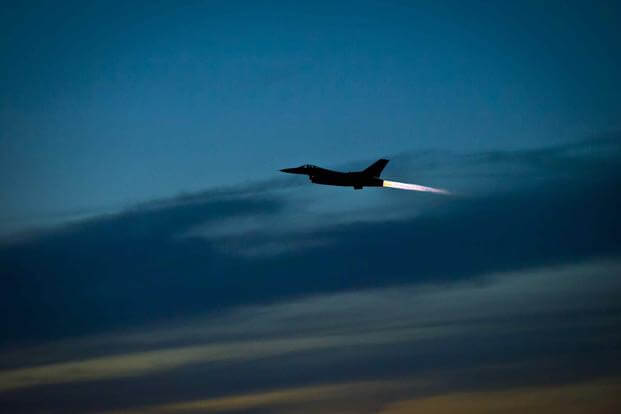The U.S. Air Force quietly changed its F-16 Fighting Falcon nighttime live-fire training after a contractor was killed during such an event in 2017, the service confirmed this week.
Following the death of Charles Holbrook, a former Tactical Air Control Party airman, Air Education and Training Command "immediately postponed all night vision-aided weapons releases with ground parties on weapons ranges and published updated guidance early in February 2017 to improve the safety of F-16 air-to-surface nighttime weapons employment and training," Aryn Lockhart, spokeswoman for the command's 19th Air Force, said in an email Monday.
Read Next: Former Naval Aviator, Astronaut Mark Kelly Defeats Martha McSally to Claim Senate Seat
News of the change was first reported by Air Force Magazine, which further detailed that freshman pilots must conduct their first nighttime training sortie alongside an instructor in a two-seater F-16D model -- not solo in their own fighter. If a D-model is not available, no live weapons are allowed onboard, the magazine reported.
Further improvements have been made since 2017, Lockhart said, to include how students employ the targeting pod -- a tracking device used for target detection and identification -- in conjunction with the use of night-vision goggles. She offered no further details on this training revision.
Holbrook died Jan. 31, 2017, at White Sands Missile Range, New Mexico, after a student pilot incorrectly identified the strike target during nighttime training, instead hitting Holbrook's location, according to court documents.
The retired master sergeant, who was working as a contractor for Sensors Unlimited, now a division of Raytheon Technologies, was critically injured when the student "mistook the line of rental cars for the similarly aligned target and was ordered to fire at the group, blowing up one of the rental cars and striking Holbrook in the head with a 20 mm round," records show.
Holbrook died several hours later at the hospital.
It was the student's "first night close-air support mission, first use of night-vision goggles while piloting the aircraft, and the first time he would be performing a nighttime high-angle strafe of unlit targets," according to investigation documents.
The student misidentified the target multiple times, which caused confusion and a miscommunication between him and his instructor pilot, the documents state. Once confusion over the target location was resolved, the instructor pilot greenlit the strike; the student then reset his targeting pod cursor, which placed him on the correct path.
But he ignored the targeting pod steering information and "actually flew a different heading that pointed him back to his original incorrect target," court records show.
In 2018, Holbrook's widow, Belen, brought a wrongful death suit for nearly $25 million against the U.S. Air Force. The instructor and student pilots were also named as defendants.
Last month, a settlement was reached for an undisclosed amount, according to Randi McGinn, the family's lawyer.
"$25 million was the initial demand, but the case was never settled for what the demand was," McGinn told Military.com in a phone call.
McGinn would not disclose the settlement amount, citing the family's privacy. "They have enough to take care of them for the rest of their lives," she said.
-- Oriana Pawlyk can be reached at oriana.pawlyk@military.com. Follow her on Twitter at @Oriana0214.
Related: Air Force Settles $25 Million Lawsuit for F-16 Strafing Run That Killed Contractor












